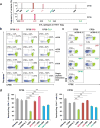Broad CTL response is required to clear latent HIV-1 due to dominance of escape mutations
- PMID: 25561180
- PMCID: PMC4406054
- DOI: 10.1038/nature14053
Broad CTL response is required to clear latent HIV-1 due to dominance of escape mutations
Abstract
Despite antiretroviral therapy (ART), human immunodeficiency virus (HIV)-1 persists in a stable latent reservoir, primarily in resting memory CD4(+) T cells. This reservoir presents a major barrier to the cure of HIV-1 infection. To purge the reservoir, pharmacological reactivation of latent HIV-1 has been proposed and tested both in vitro and in vivo. A key remaining question is whether virus-specific immune mechanisms, including cytotoxic T lymphocytes (CTLs), can clear infected cells in ART-treated patients after latency is reversed. Here we show that there is a striking all or none pattern for CTL escape mutations in HIV-1 Gag epitopes. Unless ART is started early, the vast majority (>98%) of latent viruses carry CTL escape mutations that render infected cells insensitive to CTLs directed at common epitopes. To solve this problem, we identified CTLs that could recognize epitopes from latent HIV-1 that were unmutated in every chronically infected patient tested. Upon stimulation, these CTLs eliminated target cells infected with autologous virus derived from the latent reservoir, both in vitro and in patient-derived humanized mice. The predominance of CTL-resistant viruses in the latent reservoir poses a major challenge to viral eradication. Our results demonstrate that chronically infected patients retain a broad-spectrum viral-specific CTL response and that appropriate boosting of this response may be required for the elimination of the latent reservoir.
Figures












Comment in
-
HIV: Seeking ultimate victory.Nature. 2015 Jan 15;517(7534):281-2. doi: 10.1038/nature14194. Epub 2015 Jan 7. Nature. 2015. PMID: 25561174 No abstract available.
-
Double trouble: HIV latency and CTL escape.Cell Host Microbe. 2015 Feb 11;17(2):141-2. doi: 10.1016/j.chom.2015.01.008. Cell Host Microbe. 2015. PMID: 25674977 Free PMC article.
References
-
- Siliciano JD, et al. Long-term follow-up studies confirm the stability of the latent reservoir for HIV-1 in resting CD4+ T cells. Nat Med. 2003;9:727–8. - PubMed
-
- Finzi D, et al. Identification of a reservoir for HIV-1 in patients on highly active antiretroviral therapy. Science. 1997;278:1295–300. - PubMed
-
- Chun TW, et al. Quantification of latent tissue reservoirs and total body viral load in HIV-1 infection. Nature. 1997;387:183–8. - PubMed
-
- Richman DD, et al. The challenge of finding a cure for HIV infection. Science. 2009;323:1304–7. - PubMed
Publication types
MeSH terms
Substances
Grants and funding
- T32 AI007019/AI/NIAID NIH HHS/United States
- P30 AI094189/AI/NIAID NIH HHS/United States
- P30AI094189/AI/NIAID NIH HHS/United States
- U19 AI096109/AI/NIAID NIH HHS/United States
- T32 HL007525/HL/NHLBI NIH HHS/United States
- K08 HL127269/HL/NHLBI NIH HHS/United States
- T32 AI07019/AI/NIAID NIH HHS/United States
- HHMI/Howard Hughes Medical Institute/United States
- 1U19AI096109/AI/NIAID NIH HHS/United States
- P30 AI027763/AI/NIAID NIH HHS/United States
- AI096113/AI/NIAID NIH HHS/United States
- R01 AI043222/AI/NIAID NIH HHS/United States
- K99 AI125065/AI/NIAID NIH HHS/United States
- R01 AI051178/AI/NIAID NIH HHS/United States
- U19 AI096113/AI/NIAID NIH HHS/United States
LinkOut - more resources
Full Text Sources
Other Literature Sources
Medical
Molecular Biology Databases
Research Materials

